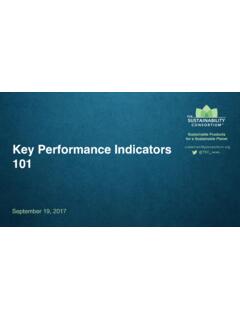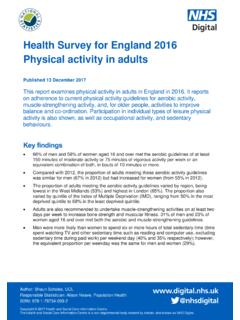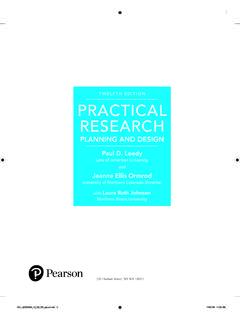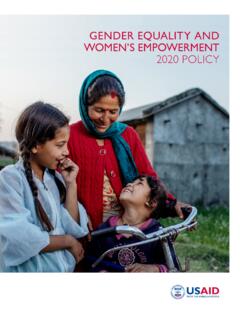Transcription of Urban green spaces and health - World Health Organization
1 Urban green spaces and Health Urban green spaces and Health A review of evidence ABSTRACT This report summarizes the available evidence of beneficial effects of Urban green spaces , such as improved mental Health , reduced cardiovascular morbidity and mortality, obesity and risk of type 2 diabetes, and improved pregnancy outcomes. Mechanisms leading to these Health benefits include psychological relaxation and stress alleviation, increased physical activity, reduced exposure to air pollutants, noise and excess heat. Characteristics of Urban green spaces that are associated with specific mechanisms leading to Health benefits, and measures or indicators of green space availability, accessibility and use that have been used in previous surveys are discussed from the perspective of their public Health relevance and applicability for monitoring progress towards goals set in international commitments, such as the Parma Declaration in the WHO European Region and the global Sustainable Development Goals.
2 The report also presents a suggested indicator of accessibility of green spaces with examples of its application in three European cities and a detailed methodological tool kit for GIS analysis of land use and population data. Keywords Urban Health Cities Environment Address requests about publications of the WHO Regional Office for Europe to: Publications WHO Regional Office for Europe UN City, Marmorvej 51 DK 2100 Copenhagen , Denmark Alternatively, complete an online request form for documentation, Health information, or for permission to quote or translate, on the Regional Office web site ( ). Citation advice: Urban green spaces and Health . Copenhagen: WHO Regional Office for Europe, 2016 . World Health Organization 2016 All rights reserved. The Regional Office for Europe of the World Health Organization welcomes requests for permission to reproduce or translate its publications, in part or in full.
3 The designations employed and the presentation of the material in this publication do not imply the expression of any opinion whatsoever on the part of the World Health Organization concerning the legal status of any country, territory, city or area or of its authorities, or concerning the delimitation of its frontiers or boundaries. Dotted lines on maps represent approximate border lines for which there may not yet be full agreement. The mention of specific companies or of certain manufacturers products does not imply that they are endorsed or recommended by the World Health Organization in preference to others of a similar nature that are not mentioned. Errors and omissions excepted, the names of proprietary products are distinguished by initial capital letters. All reasonable precautions have been taken by the World Health Organization to verify the information contained in this publication.
4 However, the published material is being distributed without warranty of any kind, either express or implied. The responsibility for the interpretation and use of the material lies with the reader. In no event shall the World Health Organization be liable for damages arising from its use. The views expressed by authors, editors, or expert groups do not necessarily represent the decisions or the stated policy of the World Health Organization . Cover photo: OPEN space Research Centre iii Editors Andrey I. Egorov 1, 2 *, Pierpaolo Mudu 1, Matthias Braubach 1 and Marco Martuzzi 1 1 World Health Organization , European Centre for Environment and Health , Bonn, Germany 2 United States Environmental Protection Agency, National Health and Environmental Effects Research Laboratory, Chapel Hill, North Carolina, the United States * AIE contributed to the report working at WHO and then at US EPA.
5 Primary authors Section 2: Catharine Ward Thompson and Eva Silveirinha de Oliveira OPEN space Research Centre, University of Edinburgh, United Kingdom Section 3: Benedict W. Wheeler and Michael H. Depledge European Centre for Environment and Human Health , University of Exeter Medical School, United Kingdom Section 4: Matilda Annerstedt van den Bosch Swedish University of Agricultural Sciences, SLU, Alnarp, and Lund University, Sweden Other contributors The following individuals contributed their expertise to the development of recommendations on Health relevant WHO indicators of Urban green space and commented on the draft report: Mark Nieuwenhuijsen, Center for Research in Environmental Epidemiology (CREAL), Barcelona, Spain Sjerp De Vries, Research Institute Alterra, Wageningen University, Wageningen, The Netherlands Thomas Cla en, University of Bielefeld School of Public Health , Bielefeld, Germany Jenny Roe, University of Virginia School of Architecture, Charlottesville, Virginia, the United States Hanneke Kruize, Dutch National Institute for Public Health and the Environment (RIVM), Bilthoven, The Netherlands Francesca Racioppi, WHO Regional Office for Europe, Copenhagen, Denmark Tanja Wolf, WHO Regional Office for Europe, Bonn, Germany Kristen Scott, Intern at the WHO Regional Office for Europe, Bonn, Germany Anne Cleary, Intern at the WHO Regional Office for Europe, Bonn, Germany.
6 Acknowledgement Glenn Rice, US Environmental Protection Agency, reviewed the report and made valuable comments. iv Disclaimer The views expressed in this report are those of the authors and do not necessarily reflect the views or policies of the Environmental Protection Agency. Mention of trade names or commercial products does not constitute endorsement or recommendation for use. v List of abbreviations ADHD Attention Deficit Hyperactivity Disorder BME (groups) black and minority ethnic (groups) CORINE Coordination of Information on the Environment EEA European Environment Agency EEG Electroencephalography EU European Union GIS Geographic Information System GPS Global Positioning System NDVI Normalized Difference Vegetation Index UV (light) ultraviolet (light) US EPA United States Environmental Protection Agency WHO World Health Organization vi Table of contents 1.
7 INTRODUCTION .. 1 2. EVIDENCE ON Health BENEFITS OF Urban green spaces .. 3 Definitions of Urban green space .. 3 Pathways linking Urban green space to improved Health and well being .. 3 Overview of pathways to Health .. 3 Improved relaxation and restoration .. 4 Improved social capital .. 5 Improved functioning of the immune system .. 5 Enhanced physical activity, improved fitness and reduced obesity .. 5 Anthropogenic noise buffering and production of natural sounds .. 7 Reduced exposure to air pollution .. 8 Reduction of the Urban heat island effect .. 8 Enhanced pro environmental behaviour .. 8 Optimized exposure to sunlight and improved sleep .. 9 Evidence of Health benefits of green spaces .. 9 Improved mental Health and cognitive function .. 9 Reduced cardiovascular morbidity .. 10 Reduced prevalence of type 2 diabetes .. 11 Improved pregnancy outcomes.
8 11 Reduced mortality .. 11 Mechanisms of potential pathogenic effects of green spaces .. 12 Increased exposure to air pollutants .. 12 Risk of allergies and asthma .. 12 Exposure to pesticides and herbicides .. 12 Exposure to disease vectors and zoonotic infections .. 13 Accidental injuries .. 13 Excessive exposure to UV radiation .. 13 Vulnerability to crime .. 13 Characteristics of Urban green space associated with specific Health benefits or hazards .. 14 Perceptions of green space accessibility and quality .. 14 Size of green space .. 15 Presence of specific facilities for certain activities .. 15 Tree cover and canopy density .. 15 Differential Health benefits of green spaces in specific population groups .. 16 Women .. 16 Children and adolescents .. 17 Older adults .. 17 Deprived subpopulations and minority groups .. 18 Populations of various countries and geographic regions.
9 19 Co benefits of Urban green spaces unrelated to Health effects .. 19 3. INDICATORS OF Urban green SPACE AVAILABILITY, ACCESSIBILITY AND USAGE, .. AND ASSESSMENT OF THEIR Health RELEVANCE .. 21 Classification of Urban green space indicators .. 21 vii green space characteristics that can be incorporated in definitions of indicators .. 21 Indicators of green space availability .. 22 Greenness, measured by Normalised Difference Vegetation Index (NDVI) .. 22 Density or percentage of green space by area .. 23 Measures of street trees and other streetscape greenery .. 24 Indicators of green space accessibility .. 25 Proximity to an Urban park or geographically defined green space .. 25 Proportion of green space or greenness within a certain distance from residence .. 26 Perception based measures of green space accessibility .. 27 Indicators of green space usage.
10 28 Summary and recommendations for a Health relevant approach to selecting .. and using indicators of Urban green space .. 29 Summary of considerations for selecting indicators .. 29 Recommendations for a primary indicator .. 30 Recommendations for secondary indicators .. 31 4. PROPOSED INDICATOR AND A DATA ANALYSIS TOOL KIT .. 32 Summary of indicator development and evaluation .. 32 Data requirements for a WHO Urban green Space Indicator .. 33 Land use data for EU countries .. 33 Land cover/use data for non EU countries .. 34 Population data .. 34 Methodology .. 34 General overview .. 34 Basic method .. 36 Complex method .. 38 Summary of the proposed indicator .. 39 5. CONCLUSIONS .. 40 6. LITERATURE .. 42 APPENDIX 1. Examples of definitions related to assessing green space availability or accessibility .. 64 APPENDIX 2. The availability of key Urban land use data for the Member States of.















